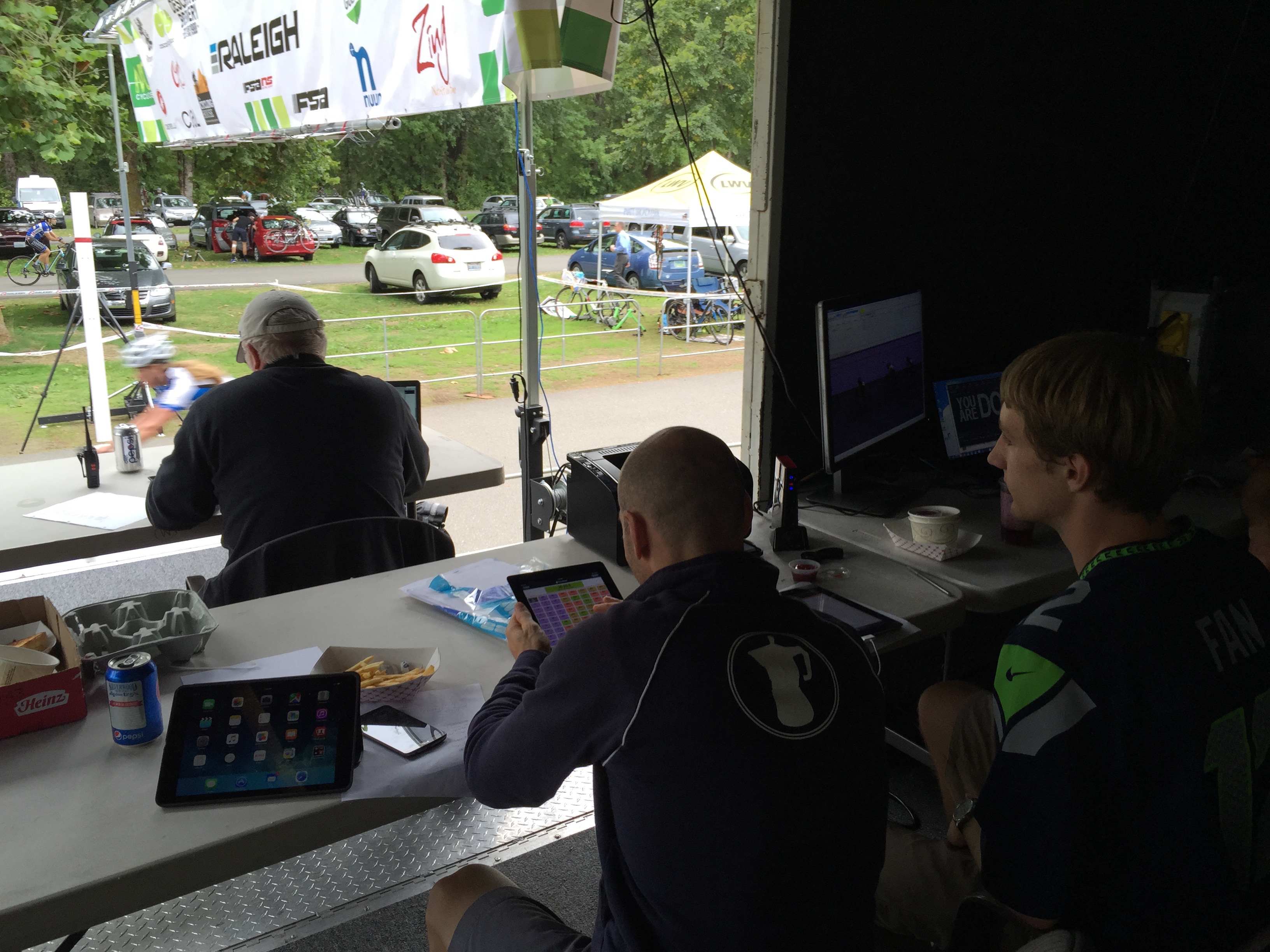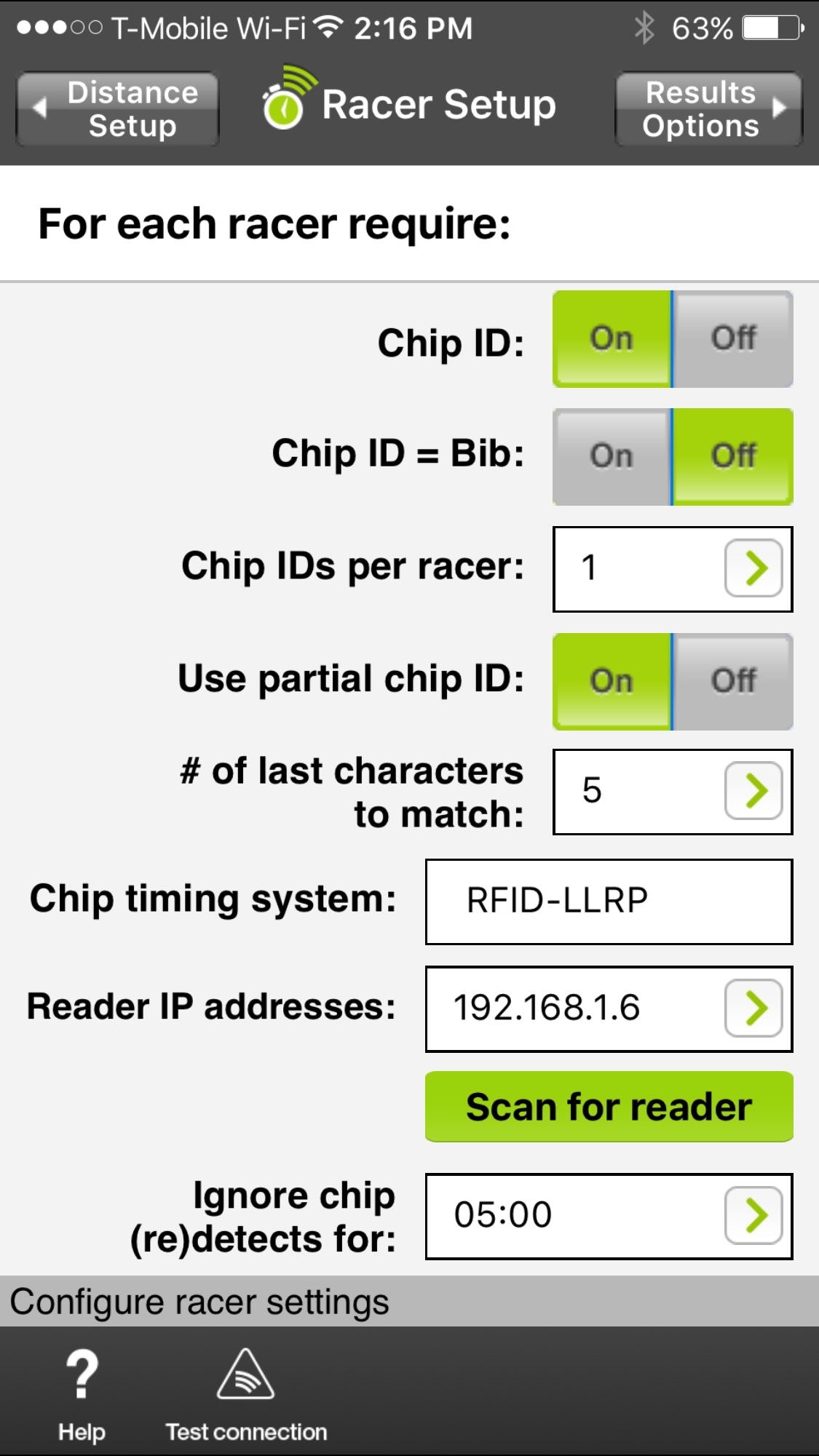Until now, Webscorer PRO has been purely a manual-timing product - you'd tap the screen to record a time & identify the racer. The 2.1 release adds support for fully automated timing where the time stamp & racer ID are received from an RFID (Radio-Frequency ID) reader device via a WiFi connection.
Webscorer PRO 2.1 can be used with LLRP-compatible readers from the leading RFID vendors:
- Alien Technology
- Honewell / Intermec
- Impinj
- Motorola / Zebra
- ThingMagic
- Radiant Sensors
Here’s how RFID chip-timing works with Webscorer PRO:
1. Racers carry an RFID chip
- The RFID chip can be attached to the bib, or tied to a shoelace / ankle or helmet etc.
- The RFID chip can be a disposable one (“passive”, no battery) or a reusable one (“active”, with battery)
2. The RFID reader is connected via an Ethernet cable to a WiFi router
3. The Webscorer PRO app, running on an iOS or Android device connects to the RFID reader via WiFi
4. At the finish line (and optionally also at the start), an RFID reader detects the chip
5. As the RFID chip ID detected, the reader automatically sends the time stamp & chip ID to the Webscorer app
6. Start list setup on Webscorer PRO
- Each racer is configured with a chip ID
- Or the RFID chip is programmed to match the bib number of the racer
7. You’ll be able to monitor the times & bib numbers appear automatically on the “Fast-tap list” as racers finish
- The racer names & times can be viewed on the “Fast-tap list” or in the “Show splits” view
- The results can be posted LIVE, as usual (the WiFi router has also a cellular connection to the internet)
Photo: From MFG Cyclocross event on September 20, 2015. The Impinj RFID reader is attached to the truss, with 4 antennas facing down. The RFID reader is attached via an Ethernet cable to the WiFi router on the table. The iPad is running Webscorer PRO 2.1 and has an active WiFI connection via the WiFi router to the reader. Results from this event: http://www.webscorer.com/race?raceid=52175

How to setup Webscorer PRO on your iOS or Android device:
1. You’d first create a WiFi connection to the WiFi router from your phone or tablet
- Go to your device’s Settings / WiFi
- Create a connection with Network = WiFi router name
2. In the Webscorer PRO setup, you’d set the “Race Setup” parameters as shown in the attached screenshot
- In the screenshot example, the chip ID is programmed with a unique 5-digit number at the end
- Each racer is assigned a bib number and a 5-digit chip ID
4. “Ignore chip (re)detects for” is the period during which the app ignores repeated reads of the same chip
- E.g. a race who just started, but then immediately came back through the finish line to drop something off
5. The RFID chip-timing feature requires the PRO subscription for automated (and manual) timing
- If you’re new to Webscorer, you can try all PRO features for free for 30 days
- The RFID reader hardware is available for rent or purchase from online stores such as http://www.atlasrfidstore.com/

Tips when timing a race with “passive” RFID chips:
1. Background on how RFID chip-timing works
- The RFID chip receives a radio signal from the RFID reader’s antenna requesting to send its chip ID back as a radio signal
- The passive RFID chip generates energy from the request signal to transmit its chip ID back
- The radio signal sent by the reader is strong, whereas the radio signal transmitted back by the RFID chip is (very) weak
- The key issue to get 100% detection rate with passive chips is that the response signal is so weak that it’s easy to get lost
- If another racer or the racer’s own body is blocking the path of the (weak) signal, the chip may not be detected
- Even if the chip on the racer is oriented in a wrong way (facing sideways vs. directed at the antenna), it may not read
2. Ways to improve detection percentage
- Make sure the racers wear the RFID chips in clear view of the RFID reader antenna
(a chip that’s sideways will send its response signal to the side)
- To avoid shorting of the chip, use foam or some other method of protecting the electric strip of the chip from water / sweat
- Assign 2 RFID chips per racer to improve the probability that one of them is detected
- Use multiple RFID antennas improve chances that one of them receives the chip ID response from the racer
- Use "active“ RFID chips containing a battery to (greatly) improve the strength of the signal from the chip to the reader
3. The accuracy of RFID chip-timing depends on the chip placement on the racer
- Typical RFID reader antennas have a 10-20 foot range
- This means a chip reader should be placed 10-20 feet from the finish line to detect the chip ID right on the line
- However, exactly when the RFID tag gets enough radio wave energy to transmit its chip ID back depends on many factors
- Whether the reader’s antenna receives the chip's 1st response depends on the direction & strength of the transmission
- The racer’s chip may thus be detected well before the finish line, right on the line, or some distance after the finish line
- For all these reasons, the accuracy for RFID chip timing is not an exact science and can vary greatly within the same race
- In a running race, typically accuracy is perhaps +/- 1 second, in a biking race +/- 0.5 seconds as the racers move quicker
- Any claims that RFID chip-timing is more accurate is an exaggeration, not based on how the RFID technology works
Questions? You can reach us as at support@webscorer.com